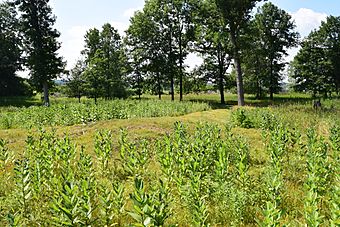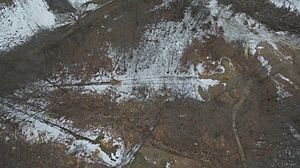Lizard Mound County Park facts for kids
Quick facts for kids |
|
|
Washington County "Island" Effigy Mound District
|
|

A mound in the park
|
|
| Lua error in Module:Location_map at line 420: attempt to index field 'wikibase' (a nil value). | |
| Nearest city | Farmington, Washington County, Wisconsin |
|---|---|
| Area | 22 acres (8.9 ha) |
| NRHP reference No. | 96000417 |
| Added to NRHP | April 25, 1996 |
Lizard Mound County Park is a special place in Washington County, Wisconsin, near West Bend, Wisconsin. It's a park managed by the county. The park was started in 1950 and became a county park in 1986. It's famous for having many old, well-preserved effigy mounds. These mounds are so important that they are listed on the National Register of Historic Places.
Contents
Discovering Lizard Mound Park
Lizard Mound County Park is found north of West Bend, Wisconsin, in the Town of Farmington. You can find it on County Trunk "A". The park is home to 28 amazing effigy mounds. These mounds are very well-preserved. Many people say they are one of the best groups of effigy mounds left in Wisconsin.
Exploring the Mounds
When you visit, you can walk along a special nature trail. This trail guides you around the park. Along the way, signs tell you about the ancient people who built these mounds. The mounds are quite tall, often more than three feet high. They were built with great care.
Unique Mound Shapes
The park has many different shapes of mounds. This variety is quite unusual. You'll see two large bird-shaped mounds. There are also seven mounds shaped like animals with long tails. These are often called "panther" effigies. One of the 28 mounds is called the "Lizard Mound." It might also show a panther, but in a unique "spread eagle" position with all four limbs showing.
Who Were the Mound Builders?
The people who built these mounds are known as the Mound Builders. They lived in Wisconsin and nearby states a long, long time ago. This was between the years A.D. 500 and A.D. 1000. They were very skilled at building these earthworks.
Life of the Ancient Builders
The Mound Builders survived by hunting, fishing, and gathering wild plants. They often moved from place to place. In summer, they stayed closer to rivers and lakes. In winter, they moved to sheltered valleys. They built mounds for burials and also shaped them like animals. These animal shapes included mammals, reptiles, birds, and even mythical creatures. They also made mounds that were conical (cone-shaped), oval, or long and straight.
Mounds as Grave Markers
The effigy mound builders usually buried their dead in small pits. Sometimes, they placed the bodies on carefully prepared surfaces. Then, they built the mounds over them. These mounds acted like special grave markers. Building these effigy burial mounds stopped about 1000 years ago. This custom was unique to this part of the world.
What We Don't Know
We don't know much else about the Mound Builders. Even the Native American tribes living in Wisconsin when the first Europeans arrived didn't know who built the mounds or why.
Discoveries at Lizard Mound
The first detailed information about the mounds at Lizard Mound County Park came from a sketch map. Professor Julius L. Torney made this map in 1883. He drew 47 Indian mounds. He also noted that some mounds had already been destroyed before he made his map. It's thought that the original group had at least 60 mounds. Many of these were the well-known animal shapes.
What Archeologists Found
Archeological digs happened in 1960. They showed that the dead were placed in pits, and the effigy mounds were built on top. Sometimes, artifacts were buried with the dead. These included clay pots, projectile points (like arrowheads), pipes, bone harpoons, and beads.
Meaning of the Shapes
People have wondered if the shapes of the mounds had a religious meaning. Or maybe they were important to different clans or family groups. But no one knows for sure why they chose these specific animal shapes.
How They Lived
Excavations at the Mound Builders' village sites tell us more about their daily lives. They lived in small nomadic groups. They hunted, fished, and gathered fruits and nuts. They made tools from stone, wood, bone, and copper. They also made pottery. They might have been the first people in Wisconsin to use the bow and arrow.
A Special Place
Lizard Mound County Park is truly unique. No other group of mounds in Wisconsin is so well-preserved. They also show such a wide variety of forms. These mounds are outstanding examples of the prehistoric art of mound building.


